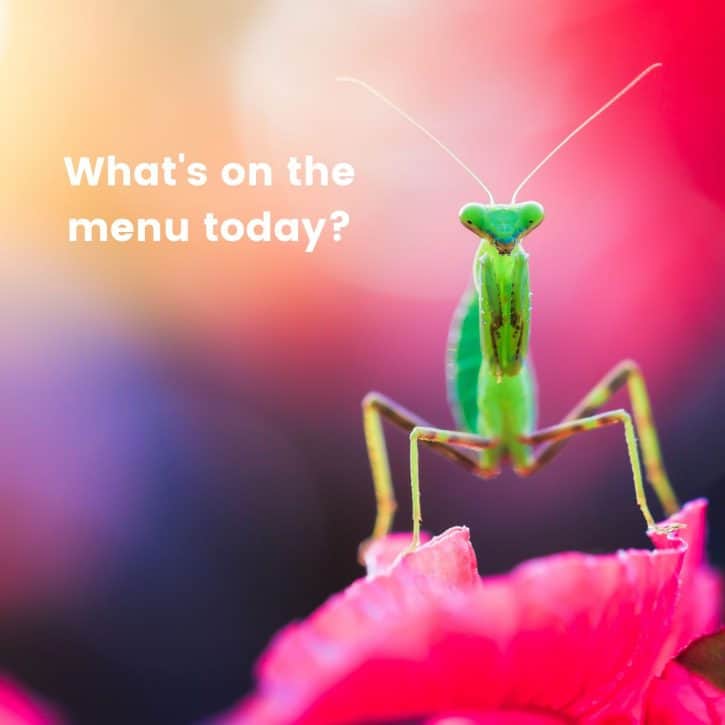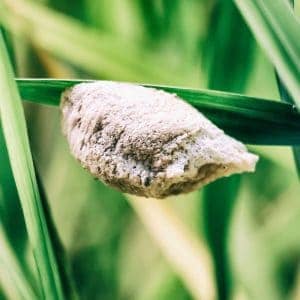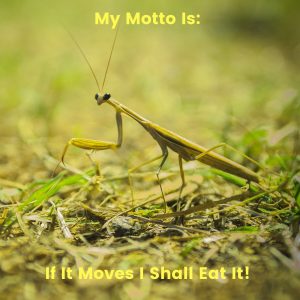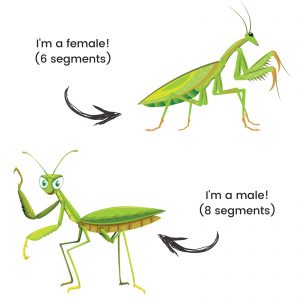May 21, 2020October 16, 2018 by C.B. Daniels


The Short Answer: A praying mantis will eat any living thing that it can capture and hold (typically arthropods).
Want more information about praying mantises and what they eat? We’ve got you covered.
Contents
2 What Do Praying Mantises Eat?
2.1 How Do Praying Mantises Get Their Food?
2.2 What Do Baby Praying Mantises (Nymphs) Eat?
2.3 What Do Adult Praying Mantises Eat?
2.4 Praying Mantis Food Options
3 How Often Should I Feed My Praying Mantis?
4 Summary of What Do Praying Mantises Eat
What Is a Praying Mantis?
A praying mantis is an insect from the order Mantodea. It is also known as a mantid (by the way the plural of praying mantis is praying mantises, praying mantes, or praying mantids). That is a lot of options for one tiny insect!
Praying mantises are invertebrates (meaning they do not have a backbone) and they are known for their iconic “praying” pose (where they bend their forearms and hold them together which gives them the appearance of praying).
This pose is anything but peaceful though! We will go over it more in depth later in the article, but this pose is used for capturing prey.
Praying mantises can range anywhere from 0.5 to 6 inches in length. In the wild, they typically live to be about one year old (in captivity a year and a half is more normal). They have triangular heads that are supported by an elongated thorax (that looks like an extended neck).
Praying mantises are the only insects that can rotate their heads 180 degrees (meaning that they can turn their heads to look over their shoulders).
While many people are aware that they have two large eyes (known as compound eyes), did you know that they also have three smaller eyes as well? These are eyes are located between the two larger ones (and are known as simple eyes).
Both male and female adult praying mantises have wings (there are some species that are wingless though), and they spend a lot of their time upside down (like bats).
Praying mantises come in a wide array of colors (green and brown are very common colors), and their body shape is similar in appearance to sticks and leaves so that they can camouflage themselves. Some praying mantises even look like flowers!

What Do Praying Mantises Eat?
Praying mantises are carnivorous (meaning they are meat eating). While they may look cute and idyllic sitting in nature, praying mantises are extremely capable predators.
Praying mantises will eat any living thing that they can capture and hold (typically arthropods).
Arthropods are invertebrates from the phylum Arthropoda (like insects and arachnids). Their lack of backbone makes them much easier for praying mantises to eat and digest.
In the wild, praying mantises will eat anything, including any creatures that are bigger than they are, like small birds or snakes. However, in captivity, it is generally recommended that you not feed them anything bigger than they are. You wouldn’t want your praying mantis to suddenly become the prey!
Praying mantises are also cannibals (meaning they will eat their own species as a source of food). A common example of this is the well-known fact that female praying mantises will sometimes decapitate and eat their mates during or after mating (which is a phenomenon known as sexual cannibalism).
Therefore, it is not advised to house praying mantises together (no matter their gender). In this case, one is not the loneliest number, but instead the happiest!
How Do Praying Mantises Get Their Food?
Praying mantises are ambush predators (which means that they capture their prey using stealth instead of relying on strength or speed).
They rely heavily on their vision (hence their many eyes) and camouflage to lure their unsuspecting victim. They wait for their prey and then use their front forearms to capture them (these forearms are also called raptorial legs or raptors).
Their forearms not only have spikes but clawed tips as well, to help them more easily capture and securely hold their prey (which they typically behead and then eat alive). Yum.
Praying mantises have astonishingly fast reflexes, and it is difficult for human beings to see them capture their prey with the naked eye. They can do this in 50-70 milliseconds!
To further put this into perspective: their reflexes are two times quicker than that of houseflies!
What Do Baby Praying Mantises (Nymphs) Eat?
Baby praying mantises (which are called nymphs) have only a slightly different diet than adult praying mantises do.
First, let’s talk about how the nymphs are born so that we can better understand their dietary preferences.
Female praying mantises lay their eggs in a frothy foamy substance that they produce (similar in texture and appearance to Styrofoam). This substance hardens around the eggs to produce a protective egg case. This case (along with the eggs) is called an ootheca.

Praying mantises can lay hundreds of eggs at one time (up to 400 eggs in some species). However, the eggs are commonly preyed upon by other insects (especially wasps), so many never see the light of day.
Typically, the eggs are laid during the fall and hatch the following spring. Their hatching is triggered by warm temperatures (the egg case is meant to protect them from the winter cold). This means if you find an ootheca and bring it inside you can hatch the nymphs early.
When they do finally hatch the nymphs emerge from small holes throughout the egg case. Praying mantises do not go through metamorphosis (transforming into an adult through several different stages), and they are born resembling adults.
The nymphs are around 4mm in size at birth and (after their exoskeleton hardens) are immediately hungry and able to eat. They are born predatory and often engage in cannibalism and eat their siblings if there is no other food available (this might be why praying mantises lay so many eggs!).
Since they do not have a separate infant form that goes through metamorphosis (like tadpoles turning into frogs), the nymphs can eat almost the same diet as adult praying mantises do.
While the nymphs follow the same eating construct as adults (they eat anything they can capture and hold), they are limited due to their smaller size (and lack of wings). Typically, they prey upon small insects (like gnats and mosquitoes).
To grow bigger and reach adulthood, nymphs go through molts (where they shed their old exoskeleton). After around six to nine molts they typically have wings, and at six months old, a praying mantis is considered an adult.
What Do Adult Praying Mantises Eat?
Adult praying mantises will eat any living thing that they can capture and hold (typically arthropods).
They will not scavenge (eat dead creatures), and they prefer their food to be moving. An adult praying mantis is only limited by what it can hold captive (which includes prey bigger than they are), and they will normally eat a wide range of insects.

The only time their diet changes is when they are molting. When this happens, they may stop eating for a couple of days either before or during (this helps them to get out of their exoskeleton a little bit easier). After molting, their exoskeleton hardens after a couple of hours, and they continue with their usual amount of eating.
Unlike many exotic pets (like reptiles), praying mantises do not require any special vitamin supplements or food powders that must be sprinkled on their food. Nor do they require any additional heating or lamps (this is mainly because praying mantises don’t have bones).
For this reason, many people like to either keep praying mantises as pets or at least have them in their yards to help keep pests under control.
If you do have outdoor praying mantises, then please keep in mind that praying mantises are not picky eaters and will even eat “good” insects. They also don’t discriminate with birds, so your hummingbirds need to watch out!
Praying Mantis Food Options
Here is a list of some praying mantis food options:
Adult
Beetles
Butterflies
Caterpillars
Crickets
Fish
Flies
Grasshoppers
Large Insects
Lizards
Moths
Small Birds
Small Mammals
Worms
Nymph
Aphids
Fruit Flies
Gnats
Larvae
Maggots
Mosquitoes
Small Crickets (also known as Micro-Crickets)
Small Insects
How Often Should I Feed My Praying Mantis?
Adult praying mantises do not require a lot of food (yay for low upkeep) and should not be fed daily. How much and how often you feed your praying mantis will depend upon its sex, size, and species.
A general rule of thumb is to feed them however much they can eat in one sitting every 2-3 days.
Typically, adult females need more food than adult males do (larger portions not more frequent feeding). If you are unsure what the gender of your praying mantis is, then look at its underside (the females have six segments on their underside, and the males have eight).

Nymphs and pregnant females also require more food (more frequently feedings) and should be fed daily.
Also, remember that when praying mantises are molting, they may not eat. So, always clean out any uneaten food (not only can it stress them out, but any uneaten live food could potentially damage them when they are vulnerable without their exoskeleton).
Praying mantises are diurnal (active during the day). So, you should feed them during daylight hours to follow their natural food cycle.
Regarding water, you do not need to provide a water bowl. In the wild, praying mantises drink water off leaves, and in captivity, you should be misting their enclosure daily (you can also provide a wet sponge).
Summary of What Do Praying Mantises Eat
Praying mantises will eat any living thing that they can capture and hold (typically arthropods).
They are carnivorous (meaning they are meat eating) and are also cannibals (meaning they will eat their own species as a source of food).
Praying mantises are ambush predators (they capture their prey using stealth instead of relying on strength or speed) and they rely heavily on their vision and camouflage to capture prey (along with their iconic “praying” forearms).
Baby praying mantises (called nymphs) have only a slightly different diet than adult praying mantises do. They are limited by their size and inability to fly, and they typically prey upon small insects.
Praying mantises will often stop eating for a few days either before or during molting (which is where they shed their old exoskeleton).
A general rule of thumb is to feed adult praying mantises however much they can eat in one sitting every 2-3 days.
How about checking out some of our other articles:
Hi my name is C.B. Daniels and I make websites. I’ve also always been fascinated by animals. I thought that some of the information about animal diets and pet names was a little thin. So I figured I’d make this site to remedy that! I hope to make this site a hub for information about what animals eat, fun names you can use for your pets, and general animal information. Hopefully, you’ll find all the information about animals you are looking for and much more!
Latest posts by C.B. Daniels (see all)
- Can Rabbits Eat Grapes? - November 12, 2022
- Can Rabbits Eat Cucumbers? - November 3, 2022
- Can Rabbits Eat Spinach? - November 3, 2022